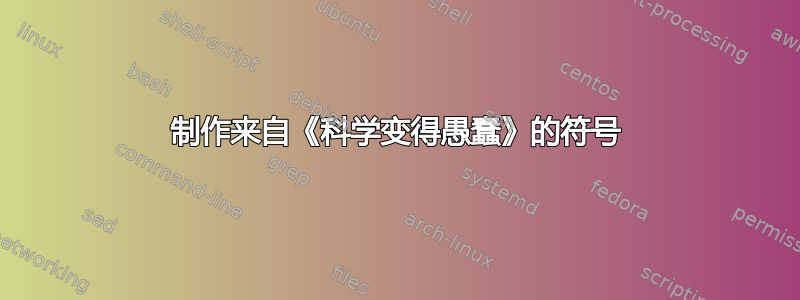
有一本有趣的获奖书籍科学变得愚蠢这本书模仿了小学教科书。书中有下表中的数学符号。
这些符号都是由 tex 中可用的典型符号组成的。但我想知道如何才能在 latex 中(在数学模式下)使用这些符号?我对前四个符号特别感兴趣——但我怀疑,一旦制作出其中任何一个符号,只需稍加调整,就可以制作出所有符号。
可能可以在 tikz 中创建符号,但我认为这在数学模式下效果不佳(例如,如果我想将“非常让人想起”作为下标怎么办?)。我对使用 中形成的临时解决方案也有类似的疑虑rotatebox。graphicx我怀疑有更好的方法。
答案1
这里使用了几种不同的技术。
- 对于“可能等于”符号,使用 Ti 绘制符号钾
\congZ 并使用包\scalerel*中的缩放到符号的高度scalerel。由于\cong脚本中的大小会发生变化,因此新符号也会发生变化。 - 对于“与...有某种关系”的符号,
\mathpalette与一起使用\rotatebox来旋转?符号。注意:\rotatebox需要graphicx由 加载的包scalerel。 - 对于“回忆”符号,
\mathpalette再次使用与符号(垂直的)\ooalign叠加在一起。=\wr\sim - 最后,对于“可能无关”符号,
\mathchoice使用是因为每种风格都需要进行微小的间距调整。
更多详情请参阅这个问题及其答案。
以下是代码:
\documentclass{article}
\usepackage{tikz, scalerel}
\newcommand{\perhaps}{\mathrel{\scalerel*{\tikz{
\useasboundingbox (0,-.2) rectangle (1,.6);
\draw[line width=1.4pt, line cap=round, line join=round](0,-.04)--(1,-.04)(0,.2)--(.4,.2)--(0,.5)(1,.2)--(.6,.2)--(1,.5);
}}{\cong}}}
\makeatletter
\newcommand{\somekind}{\mathrel{\mathpalette\some@kind\relax}}
\newcommand{\some@kind}[2]{%
\rotatebox[origin=c]{-90}{$\m@th#1?$}
}
\newcommand{\reminiscent}{\mathrel{\mathpalette\reminisc@nt\relax}}
\newcommand{\reminisc@nt}[2]{%
\ooalign{%
$\m@th#1=$\cr
\hidewidth$\m@th#1\wr$\hidewidth\cr
}%
}
\makeatother
\newcommand{\probnothing}{\mathrel{\mathchoice
{\ooalign{\rotatebox{90}{?}\cr\raisebox{1.7ex}{\rotatebox{-90}{?}}\cr}}
{\ooalign{\rotatebox{90}{?}\cr\raisebox{1.7ex}{\rotatebox{-90}{?}}\cr}}
{\ooalign{\raisebox{-.1ex}{\rotatebox{90}{$\scriptstyle ?$}}\cr\raisebox{1.25ex}{\rotatebox{-90}{$\scriptstyle ?$}}\cr}}
{\ooalign{\raisebox{-.1ex}{\rotatebox{90}{$\scriptscriptstyle ?$}}\cr\raisebox{1ex}{\rotatebox{-90}{$\scriptscriptstyle ?$}}\cr}}
}}
\begin{document}
$A\perhaps B_{A\perhaps B_{A\perhaps B}}$
$A\somekind B_{A\somekind B_{A\somekind B}}$
$A\reminiscent B_{A\reminiscent B_{A\reminiscent B}}$
$A\probnothing B_{A\probnothing B_{A\probnothing B}}$
\end{document}




